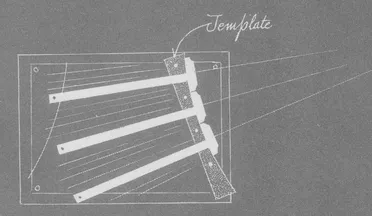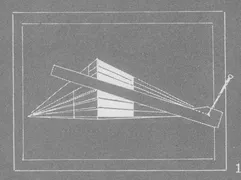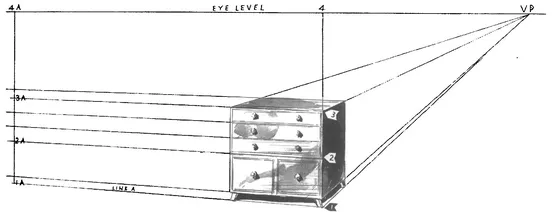
- 160 pages
- English
- ePUB (mobile friendly)
- Available on iOS & Android
eBook - ePub
Creative Perspective for Artists and Illustrators
About this book
In this thought-provoking practical guide, a noted artist and educator demonstrates that learning to violate the rules of perspective (profitably) is as important for the practicing artist as learning the principles of perspective themselves. Only in this way can students free themselves from the constraints of tradition and find their own imaginative paths. However, it is vital that students first have a solid grasp of classical perspective before they can think about adapting it creatively.
In presenting the principles of perspective drawing, Mr. Watson devotes a chapter each to step-by-step discussions of such topics as the picture plane, foreshortening and convergence, the circle, the cone, three-point perspective, universal perspective, figures in perspective, and much more. To illustrate his points he offers expert analysis of the works of such leading illustrators as John Atherton, V. Bobri, R. M. Chapin, Jr., Albert Dorne, Robert Fawcett, Constantin Guys, W. N. Hudson, Carl Roberts, Ben Stahl, and Aldren A. Watson, as well as drawings by Pieter de Hooch and Paul Cézanne. The result is a ground-breaking study that artists, illustrators, and draftsmen will find invaluable in learning to create works with convincing perspective.
Ernest W. Watson taught at Pratt Institute for over 20 years, co-founded and served as editor-in-chief of the magazine American Artist, and co-founded the prestigious art publishing house of Watson-Guptill.
In presenting the principles of perspective drawing, Mr. Watson devotes a chapter each to step-by-step discussions of such topics as the picture plane, foreshortening and convergence, the circle, the cone, three-point perspective, universal perspective, figures in perspective, and much more. To illustrate his points he offers expert analysis of the works of such leading illustrators as John Atherton, V. Bobri, R. M. Chapin, Jr., Albert Dorne, Robert Fawcett, Constantin Guys, W. N. Hudson, Carl Roberts, Ben Stahl, and Aldren A. Watson, as well as drawings by Pieter de Hooch and Paul Cézanne. The result is a ground-breaking study that artists, illustrators, and draftsmen will find invaluable in learning to create works with convincing perspective.
Ernest W. Watson taught at Pratt Institute for over 20 years, co-founded and served as editor-in-chief of the magazine American Artist, and co-founded the prestigious art publishing house of Watson-Guptill.
Frequently asked questions
Yes, you can cancel anytime from the Subscription tab in your account settings on the Perlego website. Your subscription will stay active until the end of your current billing period. Learn how to cancel your subscription.
At the moment all of our mobile-responsive ePub books are available to download via the app. Most of our PDFs are also available to download and we're working on making the final remaining ones downloadable now. Learn more here.
Perlego offers two plans: Essential and Complete
- Essential is ideal for learners and professionals who enjoy exploring a wide range of subjects. Access the Essential Library with 800,000+ trusted titles and best-sellers across business, personal growth, and the humanities. Includes unlimited reading time and Standard Read Aloud voice.
- Complete: Perfect for advanced learners and researchers needing full, unrestricted access. Unlock 1.4M+ books across hundreds of subjects, including academic and specialized titles. The Complete Plan also includes advanced features like Premium Read Aloud and Research Assistant.
We are an online textbook subscription service, where you can get access to an entire online library for less than the price of a single book per month. With over 1 million books across 1000+ topics, we’ve got you covered! Learn more here.
Look out for the read-aloud symbol on your next book to see if you can listen to it. The read-aloud tool reads text aloud for you, highlighting the text as it is being read. You can pause it, speed it up and slow it down. Learn more here.
Yes! You can use the Perlego app on both iOS or Android devices to read anytime, anywhere — even offline. Perfect for commutes or when you’re on the go.
Please note we cannot support devices running on iOS 13 and Android 7 or earlier. Learn more about using the app.
Please note we cannot support devices running on iOS 13 and Android 7 or earlier. Learn more about using the app.
Yes, you can access Creative Perspective for Artists and Illustrators by Ernest W. Watson in PDF and/or ePUB format, as well as other popular books in Arte & Técnicas artísticas. We have over one million books available in our catalogue for you to explore.
Information
chapter i
MATERIALS AND PROCEDURES
Although we are dealing with freehand perspective in this book, it will be necessary—as explained in the introduction—to use some of the procedures of instrumental perspective in the development of our experiments. Hence, the student should be supplied with the following minimum items of equipment.
A drawing board about 16 by 24 inches is recommended. A piece of illustration board the same size, tacked to one side, will give a pleasanter surface on which to work; and when drawing on tracing paper, the white illustration board underneath will be especially appreciated.
Drawing paper 16 by 12 inches or thereabouts is recommended for many drawing exercises. Larger sheets will sometimes be necessary, as smaller drawings—particularly when instrumental work is involved —will not be so accurate. The smaller the drawing, the greater the probability of inaccuracy.
A T-square of good quality, and 45 and 30-60 degree triangles-all of the transparent type—are essential. Two brass-edged rulers, one 24 inches long, a draftsman’s compass and a pair of dividers will suffice as a minimum instrumental outfit.
When making instrumental diagrams, pencils with leads of hard degree are needed—H or 2H grades. These should be sharpened with a knife to points much longer than are produced by mechanical sharpeners. The leads should be kept well-pointed during all instrumental work, in order to avoid inaccuracies that would invalidate the whole procedure. For free sketching the softer leads will be preferred.
A large pad of tracing paper (about 19 by 24) is indispensable. Get samples from your dealer and select the most transparent sheet. There is a wide range of transparency in tracing papers. The student often will want to lay the transparent sheets over photographs and reproductions of artists’ work, in order to analyze them by tracing the converging lines and extending them until they find their vanishing points. In this way much will be learned, not only of natural appearances as recorded by the camera but of illustrators’ strategy in changing the rules to meet the needs of special situations. More about this later.
Many times, in making these analyses, it will be found necessary to fasten several sheets of paper together with scotch tape in order to secure a large enough area for the location of vanishing points which may be some distance away from the picture on either side. In this event, a yardstick may be substituted for the ruler in drawing the converging lines. When the vanishing points are found to be even beyond the edges of the drawing table, the drawing can be laid on the floor and the lines projected by means of strings or threads extending from pins stuck in the picture, as shown in fig. 7.

7

8

9

10

11

12
In such a case we might assume that the illustrator who made the original drawing established his far-flung points by the same method. However, the chances are that once he had established his vanishing points with strings from two converging lines on each side, he resorted to the following device to get directions of all other converging lines without actually carrying them out to the far-flung points.
Extending a very thin wire—string is unsuited because it stretches—from pins stuck in at the vanishing points (already located, as in fig. 7) and attaching the other end to pencil points, arcs are inscribed on the drawing board as shown in fig. 8. (Good wire, as fine as thread, comes on spools.)
Templates are then cut with a sharp knife or razor blade, after having traced the arcs made on the drawing board and transferred them to thick cardboard. These templates are tacked firmly to the drawing board so that the arcs of their curved sides coincide with the arcs drawn by the wire compass demonstrated in fig. 8. Now the blade of a T-square placed against the curved side of a template (fig. 9) will always radiate from the vanishing point as it is moved along the arc; that is, its center line will. All one needs to do is to remove the blade—by removing the screws—and reset it on the stock so that one edge will be centered on the stock, as seen in fig. 10. Of course the blade must be set at exact right angles to the stock. By moving the T-square back and forth along the arcs, the direction of any line in the perspective drawing can be quickly and accurately drawn.
When a vanishing point is on the drawing board, a pin stuck upright at the vanishing point (as in fig. 11) will facilitate the drawing of converging lines. The straightedge can be placed against the pin and swung at any desired angle.
Fig. 12 demonstrates how strips of heavy cardboard, cut as shown, can be attached by pins to the vanishing points and used in place of the straightedge. Note that the pinhole in the strip must be in line with its drawing edge.
In fig. 13 we see another device for finding correct line directions when one or both of the vanishing points is beyond the edge of the drawing board. The right VP (vanishing point) is within range; the left VP is far out of bounds since the front lines of the cabinet are nearly horizontal.
We extend the vertical line of the nearest corner (1-3) upward to the eye-level (4). At any distance beyond the object at the left (the further the better) we drop a vertical from the eye-level to converging line (A)—whose direction has been determined freehand. This vertical (1A-4A) is shorter than the nearer vertical 1-4, but if it is divided proportionately into the same divisions as 1-4 we have points through which converging lines would pass on their way to their vanishing points far to the left. Thus the top of the cabinet (3) is half the height of 1-4. On the 1A-4A line we mark off a point (3A) halfway up that line. Point 2 on the cabinet is one-quarter the height; on 1A-4A we give 2A its corresponding position. Any number of measurements on 1-4 can be duplicated proportionately on 1A-4A.
13

A camera and a projection machine are indispensable tools in the contemporary illustrator’s equipment. Still more indispensable is such an inventive faculty as Frank J. Reilly brings to the solution of many of his illustration problems, of which the subject of this demonstration is an example—a picture of a marshalling yard, which ...
Table of contents
- Title Page
- Copyright Page
- Dedication
- Table of Contents
- introduction - WHAT IS CREATIVE PERSPECTIVE?
- chapter i - MATERIALS AND PROCEDURES
- chapter ii - THE STRUCTURAL APPROACH
- chapter iii - THE SQUARE AS A UNIT OF MEASURE
- chapter iv - THE PICTURE PLANE
- chapter v - THE CUBE
- chapter vi
- chapter vii - THE CIRCLE
- chapter viii - THE CONE
- chapter ix - THE HOUSE OF SEVEN VANISHING POINTS
- chapter x - FLOOR TILES
- chapter xi - UP STAIRS AND DOWN
- chapter xii - UP HILL AND DOWN
- chapter xiii - THREE-POINT PERSPECTIVE
- chapter xiv - REFLECTIONS
- chapter xv - SHADOWS
- chapter xvi - FURNITURE
- chapter xvii - UNIVERSAL PERSPECTIVE
- chapter xviii - FIGURES IN PERSPECTIVE
- chapter xix - PROBLEM OF THE BRIDGE TRUSS
- INDEX